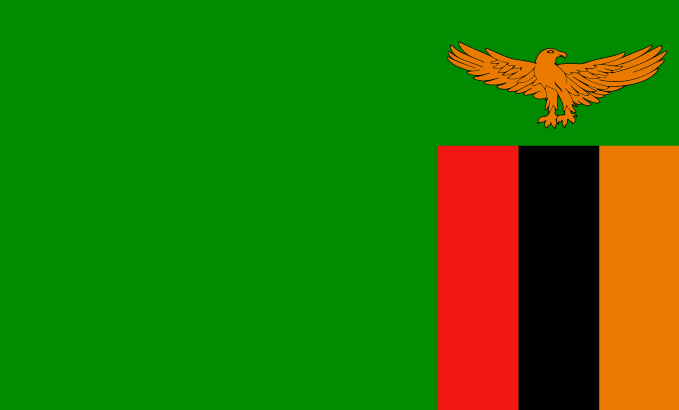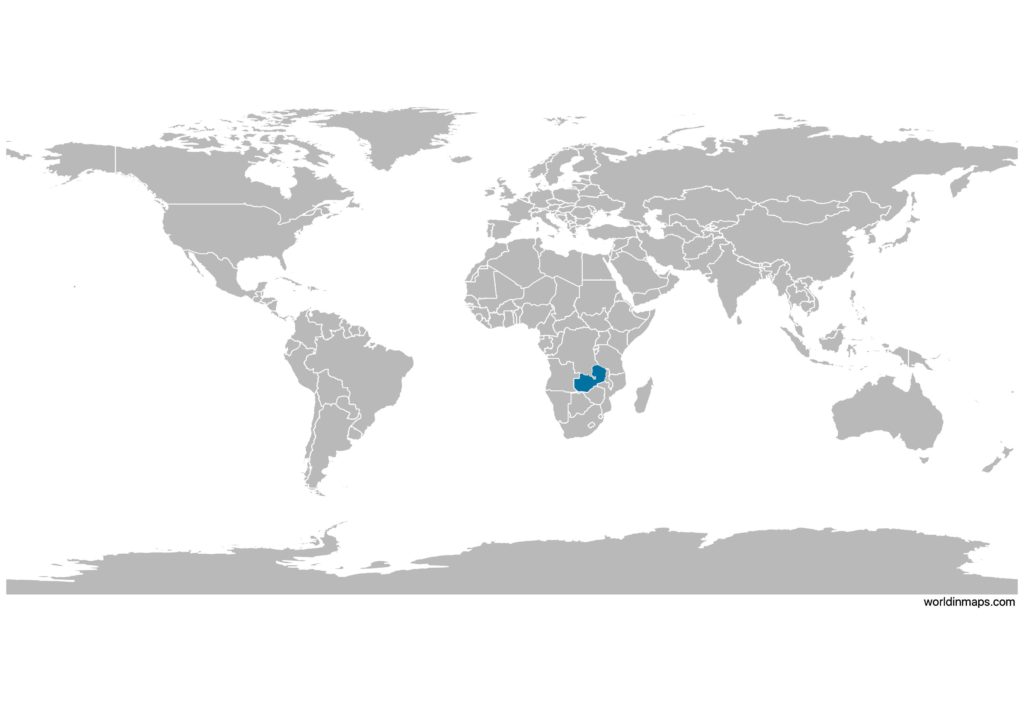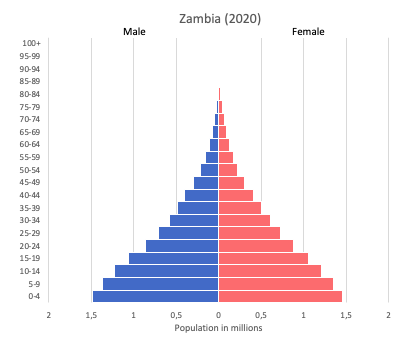Zambia

| Government | |
| Name | Republic of Zambia |
| Government type | presidential republic |
| Capital | Lusaka (1,747,152 (2010)) |
| Currency | Zambian kwacha (ZMW) |
| Organization | |
| Member State | Commonwealth of Nations |
| People | |
| Population (2020) | 18,383,956 (65th) |
| Density of population | 17.2 P/km2 (191st) |
| Nationality | Zambian |
| Official languages | |
| English | |
| Ethnic groups (2010) | |
| Bemba | 21% |
| Tonga | 13.6% |
| Chewa | 7.4% |
| Lozi | 5.7% |
| Nsenga | 5.3% |
| Tumbuka | 4.4% |
| Ngoni | 4% |
| Lala | 3.1% |
| Kaonde | 2.9% |
| Namwanga | 2.8% |
| Lunda (north Western) | 2.6% |
| Mambwe | 2.5% |
| Luvale | 2.2% |
| Lamba | 2.1% |
| Ushi | 1.9% |
| Lenje | 1.6% |
| Bisa | 1.6% |
| Mbunda | 1.2% |
| other | 13.8% |
| unspecified | 0.4% |
| Religions (2010) | |
| Protestant | 75.3% |
| Roman Catholic | 20.2% |
| other | 2.7% |
| none | 1.8% |
| Life expectancy (2020) | |
| Male | 51.9 years |
| Female | 55.3 years |
| Total population | 53.6 years (226th) |
| Homicides | |
| Total (2015) | 5.4 per 100,000 people (58th) |
| Geography | |
| Land area | 743,398 km2 |
| water area | 9,220 km2 |
| total area | 752,618 km2 (40th) |
| Mean elevation | 1,138 m |
| Lowest point | |
| Zambezi river | 329 m |
| Highest point | |
| unnamed elevation in Mafinga Hills | 2,301 m |
| Land use (2011) | |
| Agricultural land | 31.7% |
| Arable land | 4.8% |
| Permanent crops | 0% |
| Permanent pasture | 26.9% |
| Forest | 66.3% |
| Other | 2% |
| Urbanization | |
| Urban population (2020) | 44.6% |
| Rate of urbanization | 4.23% annual rate of change (2015 – 2020) |
| Economy | |
| Labor force (2017) | 6.898 million (68th) |
| Labor force by occupation (2017) | |
| Agriculture | 54.8% |
| Industry | 9.9% |
| Services | 35.3% |
| Unemployment rate (2008) | 15% (173rd) |
| GDP (PPP) (estimate 2019) | |
| Total | $76.52 billion |
| Per capita | $4,180 |
| GDP (nominal) (estimate 2017) | |
| Total | $23.137 billion |
| Per capita | $1,342 |
| GDP by sector (estimate 2017) | |
| Agriculture | 7.5% |
| Industry | 35.3% |
| Services | 57% |
| Exports (2017) | $8.216 billion (96th) |
| Exports partners (2017) | |
| Switzerland | 44.8% |
| China | 16.1% |
| Democratic Republic of the Congo | 6.2% |
| Singapore | 6% |
| South Africa | 5.9% |
| Imports (2017) | $7.852 billion (112th) |
| Imports partners (2017) | |
| South Africa | 28.2% |
| Democratic Republic of the Congo | 20.8% |
| China | 12.9% |
| Kuwait | 5.4% |
| UAE | 4.6% |
Zambia on the world map

Zambia top 10 largest cities (2010)
- Lusaka (1,747,152)
- Kitwe (501,360)
- Ndola (451,246)
- Kabwe (202,360)
- Chingola (185,246)
- Mufulira (151,309)
- Livingstone (134,349)
- Luanshya (130,076)
- Chipata (116,627)
- Kasama (101,845)
Demography
Population pyramid

Age structure data
Estimate for 2020:
- 0-14 years: 45.74% (male 4,005,134/female 3,964,969)
- 15-24 years: 20.03% (male 1,744,843/female 1,746,561)
- 25-54 years: 28.96% (male 2,539,697/female 2,506,724)
- 55-64 years: 3.01% (male 242,993/female 280,804)
- 65 years and over: 2.27% (male 173,582/female 221,316)
Remark: the age structure of a population affects a nation’s key socioeconomic issues. Countries with young populations (high percentage under age 15) need to invest more in schools, while countries with older populations (high percentage ages 65 and over) need to invest more in the health sector. The age structure can also be used to help predict potential political issues. For example, the rapid growth of a young adult population unable to find employment can lead to unrest.
Population from 1950 to 2020
Source: United Nations, Department of Economic and Social Affairs, Population Division (2019). World Population Prospects 2019, Online Edition. Rev. 1.
Evolution of the life expectancy from 1960 to 2018
Source: World Development Indicators, The World Bank
Major rivers
- Zambezi (2,575 km / 1,600 mi)
Economy
Agriculture:
corn, sorghum, rice, peanuts, sunflower seeds, vegetables, flowers, tobacco, cotton, sugarcane, cassava (manioc, tapioca), coffee, cattle, goats, pigs, poultry, milk, eggs, hides
Industries:
copper mining and processing, emerald mining, construction, foodstuffs, beverages, chemicals, textiles, fertilizer, horticulture
Exports – commodities:
copper/cobalt, cobalt, electricity; tobacco, flowers, cotton
Imports – commodities:
machinery, transportation equipment, petroleum products, electricity, fertilizer, foodstuffs, clothing
Time zone and current time in Zambia
Go to our interactive map to get the current time in Zambia